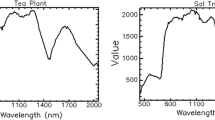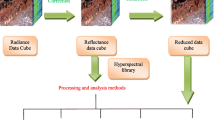Abstract
Hyperspectral remote sensing in space provides information related to surface material characteristics of spacecraft or planets that can be exploited to perform automated detection of targets of interest. At present, the detection in space environment is definitely a hot spot all over the world. So, developing the technique of multiple materials detection makes great sense. In this paper, we propose an algorithm for spatial multiple materials detection in hyperspectral images, which is based on high-order statistics and quasi-Newton method. The proposed detection algorithm, quasi-Newton-based multiple materials detector (QNMMD), exploits spectral information exclusively to make decisions by considering that each pixel contains the interesting materials or not. After single time detection, the pixel containing multiple interesting materials spectra can be exactly detected. The proposed detector has three superiorities. Firstly, due to the quasi-Newton method the proposed algorithm is relatively fast. It needs few times iteration for detecting calculation. Secondly, it performs well when the interesting materials are in low probabilities or small population with the non-Gaussian statistics. Thirdly, with regularization items the algorithm is robust to noise and works well when there are various kinds of interesting materials needing to be detected. Experimental results based on the hyperspectral image of Hubble Space Telescope prove the QNMMD algorithm is effective.







Similar content being viewed by others
Explore related subjects
Discover the latest articles, news and stories from top researchers in related subjects.References
Manolakis D, Lockwood R, Cooley T, Jacobson J (2009) Is there a best hyperspectral detection algorithm? In: Proceedings of SPIE—the international society for optical engineering
Manolakis D, Shaw G (2002) Detection algorithms for hyperspectral imaging applications. IEEE Signal Process Mag 19(1):29–43
Gu Y, Liu Y, Zhang Y (2008) A selective KPCA algorithm based on high-order statistics for anomaly detection in hyperspectral imagery. IEEE Geosci Remote Sens Lett 5(1):43–47
GA Shaw, HK Burke (2003) Spectral imaging for remote sensing. Linc Lab J 14(1):3–28
Manolakis D, Marden D, Shaw GA (2003) Hyperspectral image processing for automatic target detection applications. Linc Lab J 34(1):79–116
Manolakis DG, Ingle VK, Kogon SM (2000) Statistical and adaptive signal processing: spectral estimation, signal modeling, adaptive filtering and array processing. McGraw-Hill, Boston
Harsanyi JC (1993) Detection and classification of subpixel spectral signatures in hyperspectral image sequences, Ph.D. dissertation, Department of Electrical Engineering, University of Maryland Baltimore County, Baltimore
Farrand WH, Harsanyi JC (1997) Mapping the distribution of mine tailings in the coeur d’Alene river valley, Idaho, through the use of a constrained energy minimization technique. Rem Sens Environ 59(1):64–76
Chang CI (2003) Hyperspectral imaging: techniques for spectral detection and classification. Kluwer Academic/Plenum Publishers, New York
Kraut S, Scharf LL, McWhorter LT (2001) Adaptive subspace detectors. IEEE Trans Signal Process 49(1):1–16
Wesam S, Andrew C, Jim J, Adel S (2011) An SVDD-based algorithm for target detection in hyperspectral imagery. IEEE Geosci Remote Sens Lett 8(2):384–388
Ren H, Du Q, Chang CI, Jensen JO (2003) Comparison between constrained energy minimization based approaches for hyperspectral imagery. IEEE Workshop Adv Tech Anal Remote Sense Data 244–248
Shi Z, Yang S (2010) Robust high-order matched filter for hyperspectral target detection. Electron Lett 46(15):1065–1066
Shi Z, Yang S, Jiang Z (2011) Hyperspectral target detection using regularized high-order matched filter. Opt Eng 50(5):057201. doi:10.1117/1.3572118
Ren H, Du Q, Wang J, Chang CI, Jensen JO, Jensen JL (2006) Automatic target recognition for hyperspectral imagery using high-order statistics. IEEE Trans Aerosp Electron Syst 42(4):1372–1385
Chang CI, Jiao X, Wu CC, Du Y, Chang ML (2010) A review of unsupervised spectral target analysis for hyperspectral imagery. Eurasip J Adv Signal Process, Article ID 503752, p 26. doi:10.1155/2010/503752
Hyvärinen A, Oja E (2000) Independent component analysis: algorithms and applications. Neural Networks 13(4–5):411–430
Hyvärinen A, Karhunen J, Oja E (2001) Independent component analysis. Wiley, New York
Zhang Q, Wang H, Robert P, Paul PV (2007) Spectral unmixing using nonnegative tensor factorization. In: Proceedings of the annual Southeast conference. Winston-Salem, pp 531–532
Acknowledgments
The work was supported by the National Natural Science Foundation of China under the Grants 60975003 and 91120301, the 973 Program under the Grant 2010CB327904, the Fundamental Research Funds for the Central Universities under the Grants YWF-10-01-A10 and YWF-11-03-Q-066, the Beijing Natural Science Foundation (Non-negative Component Analysis for Hyperspectral Imagery Unmixing) under the Grant 4112036, and Program for New Century Excellent Talents in University of Ministry of Education of China under the Grant NCET-11-0775. We are also grateful to Beijing Key Laboratory of Digital Media, Beihang University.
Author information
Authors and Affiliations
Corresponding author
Rights and permissions
About this article
Cite this article
Qin, Z., Shi, Z. & Jiang, Z. A quasi-Newton-based spatial multiple materials detector for hyperspectral imagery. Neural Comput & Applic 23, 403–409 (2013). https://doi.org/10.1007/s00521-012-0932-3
Received:
Accepted:
Published:
Issue Date:
DOI: https://doi.org/10.1007/s00521-012-0932-3




